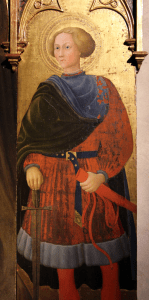We support our Publishers and Content Creators. You can view this story on their website by CLICKING HERE.
Could the life of St Galgano be linked to the Arthurian legend of the Sword in the Stone?
 In an earlier essay for The Imaginative Conservative, I recounted my discovery of the famous “Sword of St Michael” while on a hitch-hiking pilgrimage from England to Jerusalem. For those who are unfamiliar, the Sword of St Michael is a remarkable phenomenon: seven ancient monasteries dedicated to the Archangel Michael that are on a geographical straight line stretching from the Irish Sea eastward to Mount Carmel. My aforementioned essay and this one at Aleteia have more information.
In an earlier essay for The Imaginative Conservative, I recounted my discovery of the famous “Sword of St Michael” while on a hitch-hiking pilgrimage from England to Jerusalem. For those who are unfamiliar, the Sword of St Michael is a remarkable phenomenon: seven ancient monasteries dedicated to the Archangel Michael that are on a geographical straight line stretching from the Irish Sea eastward to Mount Carmel. My aforementioned essay and this one at Aleteia have more information.
Ever since that summer pilgrimage in 1987 I have been intrigued by the St Michael Line. Was it real? I tracked down a fellow who uses satellite technology to improve the accuracy of maps and gave him the coordinates of the seven sites. He came back with the information that not only were the sites on a straight line, with a variance of less than fifteen miles, but the line seemed to accommodate the curvature of the earth. The monasteries were founded as early as the fifth century—most of them the result of a vision of the Archangel Michael to their founders. Were their foundations linked? Was the geographical straight line intentional? If so, who devised it? I met with an expert in medieval cartography at the British Museum, and he confirmed my suspicion that the medieval world did not possess the knowledge or technology to accomplish such a feat.
Some researchers rightly point out that there are dozens of churches on hilltops dedicated to St Michael as the archangel would be—according to Christian lore—the first of the heavenly cohort to set foot on earth at the Lord’s second coming. Giving him a hilltop was therefore to give him a first foothold in his invasion of this world from the heavenly realm.
Furthermore, Christian churches were often established on the sites of pagan shrines, and indeed in France there are a number of hilltop churches dedicated to “St Michel de Mercure” (St Michael of Mercury), God’s winged messenger obviously replacing Mercury, the winged messenger of the pagan gods. Those who look for a natural explanation observe that with so many St Michael churches, it would not be surprising that, with a bit of imagination and ingenuity, one might discern a mystical connection among them.
In this essay, Jared Staudt observes that the monasteries are perfectly aligned with the sunset on the summer solstice and muses on the spiritual significance of the seasonal changes for the ancients. Being more attuned to the shifts of seasons and the cycles of the sun, did our forefathers in the faith see in the turning cycles of the seasons a spiritual reflection of the need for spiritual renewal? While the explanation seems reasonable to the modern questing mind, one still comes back to the astounding accomplishment of these monasteries.
Skellig Michael is a collection of beehive monastic cells clinging to a barren rock in the Irish Sea. Established sometime between the sixth and eighth centuries, the island is difficult to access even today. A handful of monks lived there for centuries existing on the vegetables they could grow in their tiny terraced gardens, supplemented with the eggs of sea birds and the meager catch of fish. Why go there to live? To give people a spiritual reminder of the sunset in summer?
St Michael’s Mount in Cornwall and most famously, Mont St Michel in France, are built on islands—Mont St Michel in a bay made hazardous by unpredictable tides and deadly quicksand. Why build there? Why build such astonishing structures? Sacra di San Michele (go here for a virtual tour) is built on a rugged peak in the Italian Alps as a result of a vision of St Michael to the founder. Building any structure there would be hugely expensive and nearly impossible even today—but in the eleventh century? All this to give Christians a devotional aid by linking to the midsummer sunset?
I continued to scratch my head. Then, in a recent visit to Tuscany—spurred by a story told to me by Rod Dreher—I looked further into the story of twelfth century St Galgano Guidotti. According to legend, while on the road near Siena, Galgano’s horse threw him and an angel lifted him to his feet and led him to a rugged hill called Monte Siepi. There he experienced a vision of Jesus, the Blessed Virgin, and the Apostles. The angel urged him to repent, but Galgano protested that he could no more repent than split a rock with a sword. To prove his point, he drew his blade and thrust at the stony ground, but the sword slid easily into the living rock, where it remains stuck fast to this day.
Galgano set up a hermitage on the site and lived a saintly life. He died in 1181, and three years later the Cistercians established a monastery nearby dedicated to his memory. He was actually the first saint to be formally canonized by the Church in 1185.
Galgano’s sword in the stone is at the small rotunda at Montsiepi near the ruined Cistercian Abbey. Go here for a BBC video about St Galgano, the sword’s authenticity, and possible links to the Arthurian legend. Could the life of St Galgano be linked to the Arthurian legend of the Sword in the Stone? Scholars disagree. Some trace the tale from Tuscany through the troubadours like Chretien de Troyes and then to Britain. The first written mention of Arthur’s sword in the stone is Robert de Boron’s French romance Merlin (dated 1200) but assuming that de Boron’s tale is based on earlier oral sources it would seem that the first traces of the Arthurian legend pre-date St Galgano. Furthermore, the elaborate romance of the future king of the Britons and the geographical and cultural distance from twelfth century Tuscany would make the connection between King Arthur’s sword and the hermit Galgano no more than a co incidence.
What is interesting is St Galgano’s vision of St Michael, the existence of the sword in the stone, a monastery founded on the site… and the fact that upon my further research, it turns out that St Galgano’s hermitage and his sword in the stone also lie exactly on the famous St Michael Line—otherwise known as the sword of St Michael.
So go figure!
The Imaginative Conservative applies the principle of appreciation to the discussion of culture and politics—we approach dialogue with magnanimity rather than with mere civility. Will you help us remain a refreshing oasis in the increasingly contentious arena of modern discourse? Please consider donating now.
The featured image, uploaded by Sailko, is “Adoration of the Shepherds between Saints Augustin and Galgano by Pietro di Giovanni d’Ambrogio.” This file is licensed under the Creative Commons Attribution 3.0 Unported license, courtesy of Wikimedia Commons.
Share This Story, Choose Your Platform!
Go to Top

 Conservative
Conservative  Search
Search Trending
Trending Current News
Current News 





